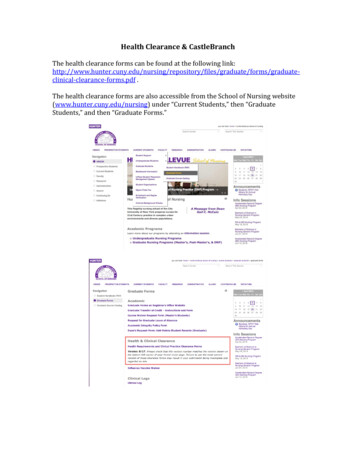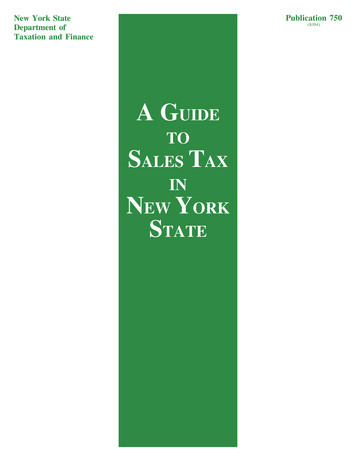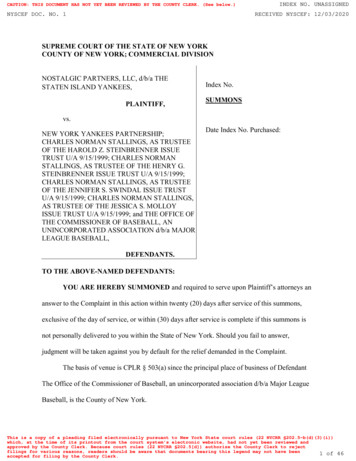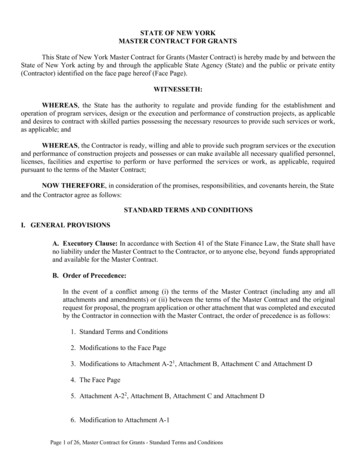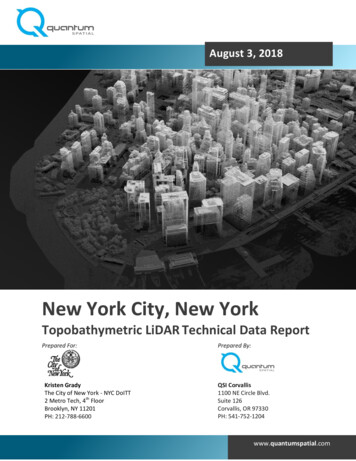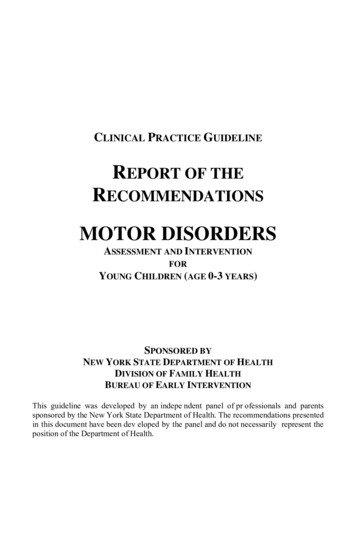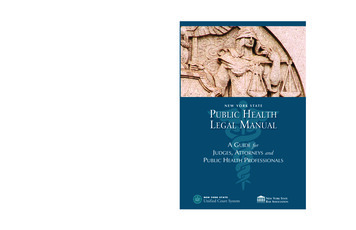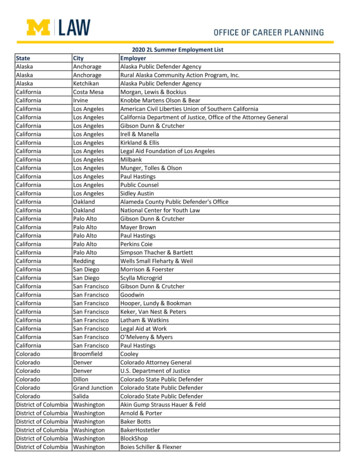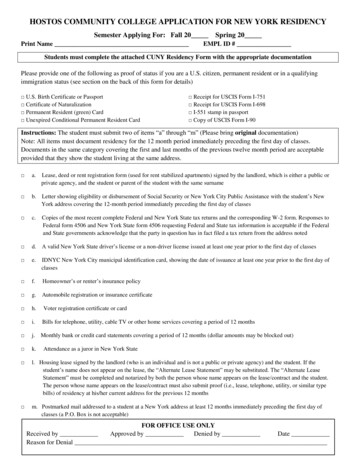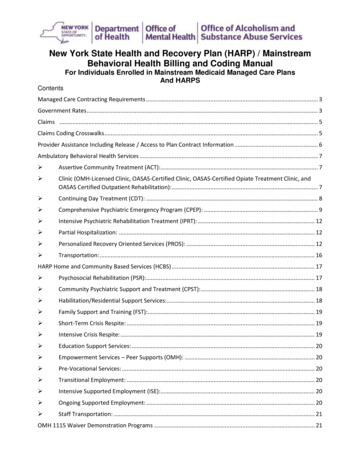
Transcription
New York State Health and Recovery Plan (HARP) / MainstreamBehavioral Health Billing and Coding ManualFor Individuals Enrolled in Mainstream Medicaid Managed Care PlansAnd HARPSContentsManaged Care Contracting Requirements . 3Government Rates . 3Claims . 5Claims Coding Crosswalks. 5Provider Assistance Including Release / Access to Plan Contract Information . 6Ambulatory Behavioral Health Services . 7 Assertive Community Treatment (ACT):. 7 Clinic (OMH-Licensed Clinic, OASAS-Certified Clinic, OASAS-Certified Opiate Treatment Clinic, andOASAS Certified Outpatient Rehabilitation): . 7 Continuing Day Treatment (CDT): . 8 Comprehensive Psychiatric Emergency Program (CPEP): . 9 Intensive Psychiatric Rehabilitation Treatment (IPRT): . 12 Partial Hospitalization: . 12 Personalized Recovery Oriented Services (PROS): . 12 Transportation: . 16HARP Home and Community Based Services (HCBS) . 17 Psychosocial Rehabilitation (PSR):. 17 Community Psychiatric Support and Treatment (CPST): . 18 Habilitation/Residential Support Services: . 18 Family Support and Training (FST):. 19 Short-Term Crisis Respite: . 19 Intensive Crisis Respite: . 19 Education Support Services: . 20 Empowerment Services – Peer Supports (OMH): . 20 Pre-Vocational Services: . 20 Transitional Employment: . 20 Intensive Supported Employment (ISE):. 20 Ongoing Supported Employment: . 20 Staff Transportation: . 21OMH 1115 Waiver Demonstration Programs . 21
May 18, 2017New York State Office of Alcoholism and Substance Abuse Services (OASAS) – Substance Use Disorder (SUD)Services and Billing . 23Manual Purpose: . 23Section One - Part A: . 25Section One – Part B: . 28Section One – Part C: . 29Section Two: Reimbursement for SUD and Addiction Services. 31Table One: OASAS Outpatient Rate Codes . 37Table Two: Outpatient CPT / HCPCS Coding. 38Section Three . 42OMH/OASAS Behavioral Health Billing Manual for Medicaid Managed Care Plans and HARPSPage 2
May 18, 2017IntroductionThis manual outlines the claiming requirements necessary to ensure proper behavioral health claimsubmission with respect to Mainstream Medicaid Managed Care Plans (MMCs) and Health andRecovery Plans (HARPs). Each behavioral health service transitioning to the Medicaid managedcare reimbursement model is covered in detail. This manual should be used in conjunction with thecoding crosswalks of rate code to procedure code/modifier code combinations that have beenprepared by OMH/OASAS for use by both Plans and providers. Both crosswalks are available asExcel files. There is one crosswalk for the existing State Plan services and another for the newHome and Community Based Services (HCBS) that will be available to many HARP members.This billing manual does not apply to office-based practitioner billing. It applies only to behavioralhealth services that can be billed under Medicaid fee-for-service rate codes by OMH-licensed orOASAS-certified programs and to the HCBS services that will be delivered by OMH and OASAS“designated” providers.Note: This manual addresses billing guidance only. It does not supersede applicable regulatoryrequirements or procedures for admission to a program, record keeping, initial and on-goingtreatment planning and reviews, etc. Those standards are in the regulations for each program.Managed Care Contracting RequirementsBeginning with the start of the behavioral health transition to Medicaid managed care in eachgeographic area, and for the first two years (based on the regional carve-in/implementationschedule) following, managed care plans will be required to contract with providers that serve five ormore of their enrolled individuals. This requirement will help ensure that individuals alreadyreceiving behavioral health services continue to receive the services they need without interruption.The specifics of this requirement are as follows:OMH Programs: For each OMH-licensed program type, Plans must contract with providers thatserve five or more of their enrollees.OASAS Programs: Plans must contract with a provider having five or more of the Plan’s enrolleesin any combination of Clinic, Outpatient Rehabilitation, or Opioid Treatment Programs (OTP). ThePlan must contract with the provider for all of the provider’s program types. Plans must also contractwith all OASAS-certified Opioid Treatment Programs in their service area, regardless on the numberof Plan enrollees serve by that OTP.Each Plan has already received a list of providers that meet this contracting requirement. AnyOMH/OASAS provider that believes it meets the threshold requirement with a particular Plan, butwho has not yet been contacted by that Plan should contact OMH at (518) 474-6911 or OASAS atPICM@oasas.ny.govGovernment RatesNew York State law currently requires that Medicaid MCOs pay the equivalent of Ambulatory PatientGroup (APG) rates for OMH licensed mental health clinics. Beginning October 1, 2015 in NYC andJuly 1, 2016 in counties outside of NYC, Plans will be required to pay 100% of the Medicaid fee-forOMH/OASAS Behavioral Health Billing Manual for Medicaid Managed Care Plans and HARPSPage 3
May 18, 2017service (FFS) rate (aka, “government rates”) for selected behavioral health procedures (see listbelow) delivered to individuals enrolled in mainstream Medicaid managed care plans, HARPs, andHIV Special Needs Plans (SNPs) when the service is provided by an OASAS and OMH licensed,certified, or designated program. This requirement will remain in place for the first two years (basedon the regional carve-in/implementation schedule). For the new HCBS services, the governmentrate is the reimbursement listed for each program on the HCBS Fee Schedule.Government rates are required for the following four categories of services:OASAS Government Rate Services (Mainstream Managed Care, HIV-SNP, and HARP): OASAS Clinic Opiate Treatment Programs (outpatient) Outpatient Rehabilitation Part 820 – OASAS per Diem Residential Addiction Treatment ServicesOMH Government Rate Services (Mainstream Managed Care, HIV-SNP, and HARP): Assertive Community Treatment (ACT) OMH Clinic (government rates are already mandated for Clinic – continue to use existingbilling procedures) Comprehensive Psychiatric Emergency Program (CPEP), including Extended ObservationBeds (Note: For CPEP EOB services, Plans are required to pay only 80% of the FFS rate,as opposed to the 100% that is required for all other government rates services. All otherCPEP services must be paid at 100% of FFS) Continuing Day Treatment (CDT) Intensive Psychiatric Rehabilitation Treatment (IPRT) Partial Hospitalization Personalized Recovery Oriented Services (PROS)HARP-Only Home and Community Based Services (HCBS) HCBS Services Manual Psychosocial Rehabilitation (PSR) Community Psychiatric Support and Treatment (CPST) Habilitation/Residential Support Services Family Support and Training Short-term Crisis Respite Intensive Crisis Respite Education Support Services Empowerment Services – Peer Supports Pre-Vocational Services Transitional Employment Intensive Supported Employment (ISE) Ongoing Supported Employment Staff Transportation Non-Medical Patient Transportation (Note: As is already the case with medicaltransportation, non-medical transportation will be carved out of the Plan benefit, managed bya transportation manager based on the Plan of Care, and paid FFS directly to thetransportation provider).OMH/OASAS Behavioral Health Billing Manual for Medicaid Managed Care Plans and HARPSPage 4
May 18, 20171115 Waiver Demonstration Programs (Mainstream Managed Care, HIV-SNP, and HARP) SUD Residential Treatment – Per Diem (Stabilization and Rehabilitation) Crisis Intervention Service OASAS Off-site SUD Services (practitioner must work for a clinic, APG rates will apply) OMH Community Mental Health Services (Other Licensed Practitioners) (practitioner mustwork for a clinic, APG rates will apply)ClaimsElectronic claims will be submitted using the 837i (institutional) claim form. This will allow for use ofrate codes which will inform the Plans as to the type of behavioral health program submitting theclaim and the service(s) being provided. Rate code will be a required input to MEDS (the MedicaidEncounter Data System) for all outpatient MH/SUD services. Therefore the Plan must accept ratecode on all behavioral health outpatient claims and pass that rate code to MEDS. All other serviceswill be reported to MEDS using the definitions in the MEDS manual.Providers will enter the rate code in the header of the claim as a value code. This is done in thevalue code field by first typing in “24” and following that immediately with the appropriate four digitrate code. This is the standard mechanism historically and currently used in Medicaid FFS billing.This field is already used by Plans to report the weight of a low birth weight baby.NYS will give Plans a complete listing of all existing providers and the rate codes they bill under, aswell as the rate amounts by MMIS provider ID and locator code and/or NPI and zip 4. This list willalso be posted on the OMH and OASAS websites.Billing requirements depend on the type of service provided; however, every electronic claimsubmitted will require at least the following: Use of the 837i claim form;Medicaid fee-for-service rate code;Valid procedure code(s);Procedure code modifiers (as needed); andUnits of service.Claims Coding CrosswalksAttached are crosswalks for HCBS and all other ambulatory behavioral health services (including1115 demo services). Also included in the crosswalk is the per diem rate / HCPCS / modifier codesfor clinic services delivered in OASAS Part 820 Residential settings. Much additional OASASinformation is in tabular form near the end of this manual. These crosswalks provide a link betweenexisting FFS rate code-based billing and the unique rate code/procedure code/modifier codecombinations that will be required under Medicaid managed care. Providers will use these codingOMH/OASAS Behavioral Health Billing Manual for Medicaid Managed Care Plans and HARPSPage 5
May 18, 2017combinations to indicate to the Plan that the claim is for a behavioral health service provided by abehavioral health program, and is to be paid at the government rate. The procedure and modifiercode combinations have been created such that even if rate code did not exist, the Plan would beable to differentiate between the various services and mirror the correct FFS payment amount.Provider Assistance Including Release / Access to Plan Contract InformationAs part of the state qualification process plans are required to develop and implement acomprehensive provider training and support program for network providers to gain appropriateknowledge, skills, and expertise and receive technical assistance to comply with the requirementsunder managed care. Training and technical assistance shall be provided to BH network providerson billing, coding, data interface, documentation requirements, and UM requirements. BH networkproviders shall be informed in writing regarding the information requirements for UM decisionmaking, procedure coding and submitting claims. Plans will provide technical assistance in otherareas such as claim submission as indicated by provider performance identified through the Plan’sQM and provider profiling programs. Plans will ensure providers receive prompt resolution to theirproblems.To facilitate a smooth transition from fee-for-service to plan billing it is expected that plans will reachout to and offer billing / claim submission training to newly BH providers; this should include a claimssubmission testing environment; and, issuance of plan contact and support information to assistprograms in claim submission.Service CombinationsOnly certain combinations of HCBS and State Plan services are allowed by Medicaid within anindividual’s current treatment plan. The grid below shows the allowable service combinations.Allowable Billing Combinations of OMH/OASAS State Plan Services and HCBSHCBS/StatePlan tationYesYesYesFamilySupport YesPeer vicesOMH/OASAS Behavioral Health Billing Manual for Medicaid Managed Care Plans and HARPSPage 6
May 18, 2017Note: The State will periodically be reviewing claim and encounter data annually, or upon informationthat there has been fraud or abuse, to determine if inappropriate HCBS and state plan servicecombinations were provided/allowed. In instances where such combinations are discovered, the state willmake the appropriate recoveries and referrals for judicial action.Ambulatory Behavioral Health Services Assertive Community Treatment (ACT):ACT regulations(part 508)ACT program guidelinesACT services are billed once per month using one rate code for the month’s services. There arethree types of monthly payments which are dependent on the number and type of contacts withthe recipient or collaterals: full, partial, or inpatient. Claims are submitted using the last day ofthe month in which the services were rendered as the date of service. A contact is defined as aface-to-face interaction of at least 15 minutes duration where at least one ACT service isprovided between an ACT team staff member and the recipient or collateral. The attachedcrosswalk indicates the procedure code (H0040) and modifier combinations to be used with theACT rate codes.ACT Full Payment (Rate Code 4508)Full payment requires at least 6 contacts with the recipient or collateral, or at least 4 communitybased contacts and at least 6 contacts in total (combination of community and inpatientcontacts), if the recipient is admitted or discharged from an inpatient setting during the month.ACT Partial Payment (4509)Partial payment requires at least 2 community-based contacts, or at least 1 community-basedcontact and at least 2 contacts in total (combination of community-based and inpatient contacts)if the recipient is admitted or discharged from an inpatient setting during the month.ACT Inpatient Payment (4511)If the recipient has an inpatient stay and at least 2 inpatient contacts are provided, then the claimqualifies for the inpatient payment. Clinic (OMH-Licensed Clinic, OASAS-Certified Clinic, OASAS-CertifiedOpiate Treatment Clinic, and OASAS Certified Outpatient Rehabilitation):OMH Clinics: OMH Clinic Regulations(part 599)OMH Clinics, both hospital-based and free-standing, have been billing FFS under the APG ratesetting methodology, using rate code, procedure code, and modifier code combinations, sinceOctober 1, 2010. For non-SSI recipients enrolled in managed care, OMH Clinics have beenbilling Medicaid plans for those same rate code, procedure code, and modifier codecombinations, and receiving the government rate (APG rate) for those services, since September1, 2012. As of the effective date of the behavioral health managed care carve-in and thecreation of the HARPs, plans will cover OMH clinic services for all enrollees and mirror the APGrates as they do now for the non-SSI population.OMH/OASAS Behavioral Health Billing Manual for Medicaid Managed Care Plans and HARPSPage 7
May 18, 2017Note on Telepsychiatry in OMH Clinics:The Office of Mental Health has amended 14 NYCRR Part 599 (Clinic Treatment Services),effective April 30, 2015, to include a new section 599.17 which allows clinic providers to obtainapproval from OMH to offer telepsychiatry services in OMH-licensed clinics. Plans are expectedto reimburse at the government (APG) rate for telepsychiatry services provided by clinics thathave been authorized by OMH to provide this optional service. Detailed information regardingtelepsychiatry may be found on the OMH telepsychiatry webpage.OASAS TITLE 14 NYCRR PART 822 OUTPATIENT OASAS Program RegulationsClinics, Opiod, and Rehabilitation Programs: For a complete description of OASASOutpatient and Inpatient programs please see the SUD Section of this manual.Prior to the BH carve-in and the implementation of the HARPs, Title 14 NYCRR Part 822 OASASclinic services (for all three types of OASAS clinics) were billed FFS (carved out) for all managedcare enrollees. Those clinics bill FFS using APG rate codes for free-standing clinics and nonAPG rate codes for hospital-based clinics. While, OASAS hospital-based clinics still use nonAPG rate codes, but are expected to move to the APG billing system, on a retroactive basis, inthe near future.For both Freestanding and Hospital Based Programs, OASAS outpatient service reimbursementwill employ government rates upon being carved into Managed Care (including HARPs). Theformat for billing and reimbursement in Managed Care is the same as FFS. Managed CarePlans should continue to use the same techniques they currently use to identify APG claims forOMH Clinics and adapt those techniques to identify OASAS outpatient services. For a completelist of the OASAS outpatient program rates codes, please see the SUD section of this manual.Important!!! Just as will be the case with free-standing OASAS programs, hospitals willuse APG rate codes and APG billing techniques when submitting claims to the Plans andthe Plans will use the APG methodology to calculate payments. The capitation rates thatwere calculated for the HARPs and the BH carve-in took this change into account and arefully funded for this implementation. The State Plan Amendment that controls FFSbehavioral health APGs in hospitals was just approved by CMS. Consequently, that FFSpayment methodology must be mirrored in managed care. Continuing Day Treatment (CDT):CDT Operational Regulations(section 587.10)CDT Reimbursement Regulations(section 588.7)CDT services are billed on a daily basis. The rates of reimbursement are separated into 3 tiers:1-40 hours, 41-64 hours and 65 hours. These three tiers span across two types of visits: fullday (4 hours minimum) and half-day (2 hours minimum). Tiers are determined by totaling thenumber of full-day and half-day regular visits, based on their hour equivalents. As the hoursaccumulate throughout the month, the provider will need to move from one tier to another to bill.Each subsequent tier has a decline in payment. Providers must keep track of the number ofhours of service provision in order to know what rate code (tier) should be billed. When theprogram hours of any single visit include more than one tier, the provider of service will bereimbursed at the tier that applies to the first hour of that visit. Each CDT service tier has aunique combination of rate code/procedure code/modifier code(s), as indicated on the attachedcrosswalk.OMH/OASAS Behavioral Health Billing Manual for Medicaid Managed Care Plans and HARPSPage 8
May 18, 2017Half-Day Visit (4310, 4311, 4312) – Requires a minimum duration of two hours. To be eligiblefor reimbursement for a half-day visit, one or more medically necessary services must beprovided and documented.Full-Day Visit (4316, 4317, 4318) – Requires a minimum duration of four hours. To be eligiblefor reimbursement for a full-day visit, three or more medically necessary services must beprovided and documented.Claims for collateral, group collateral, preadmission and crisis visits are billed separately (i.e., ondifferent claims) from the CDT regular visits using the rate codes below. The reimbursement isthe equivalent to the half-day, tier 1 amount, regardless of the cumulative total of hours for CDTregular visits in that month. Collateral, group collateral, preadmission and crisis visits areexcluded from the calculation of the cumulative total hours in the program for a recipient.Collateral Visit (4325) – Clinical support services of at least 30 minutes duration of face-to-faceinteraction documented by the provider between one or more collaterals and/or family membersof the same enrolled recipient and one therapist with or without a recipient.Group Collateral Visit (4331) – Clinical support services of at least 60 minutes duration of faceto-face interaction documented by the provider between collaterals and/or family members ofmultiple recipients of the continuing day treatment provider and one therapist with or without therecipients.Crisis Visit (4337) – Crisis intervention services are face-to-face interactions documented by theprovider between a recipient and a therapist, regardless of the actual duration of the visit.Preadmission Visit (4346) – Services of at least 60 minutes duration of face-to-face interactiondocumented by the provider between a recipient and a therapist. Comprehensive Psychiatric Emergency Program (CPEP):CPEP Operational Regulations (part 590)CPEP Reimbursement Regulations (part 591)CPEP is claimed on a daily basis. A patient may receive one brief or one full emergency visitservice in one calendar day. If a patient receives one of each, the CPEP will receivereimbursement for the full emergency visit. A provider may be reimbursed for either one crisisoutreach service or one interim crisis service and either one brief or one full emergency visit perrecipient, per one calendar day. If more than one service is provided, then more than one claimmust be submitted (one claim for each rate code). Each CPEP service has a combination of ratecode/procedure code/modifier code indicated on the attached crosswalk.Brief Emergency Visit (4007) – Face-to-face interaction between a patient and a staffphysician, preferably a psychiatrist, to determine the scope of emergency service required. Thisinteraction should include a mental health diagnostic examination. It may result in further CPEPevaluation or treatment activities on the patient's behalf or discharge from the CPEP. Note:Services provided in a medical/surgical emergency or clinic setting for comorbid conditions areseparately reimbursed. If medical and/or nursing evaluations provided outside the CPEP areutilized by the CPEP, the CPEP may be reimbursed for a brief emergency visit only. ForOMH/OASAS Behavioral Health Billing Manual for Medicaid Managed Care Plans and HARPSPage 9
May 18, 2017example – a patient is evaluated and/or treated in the emergency room (non-CPEP) for amedical condition and subsequently transferred to the CPEP for evaluation. Both the emergencyroom (non-CPEP) and the CPEP may submit claims. The CPEP should utilize the evaluationcompleted by the emergency room and submit a claim for a brief visit.Full Emergency Visit (4008) – A face-to-face interaction between a patient and a psychiatristand other clinical staff as necessary to determine a recipient's current psychosocial and medicalcondition. It must include a psychiatric or mental health diagnostic examination; psychosocialassessment; and medical examination; which results in a comprehensive psychiatric emergencytreatment plan and a discharge plan when comprehensive psychiatric emergency program orservices are completed. It may include other examinations and assessments as clinicallyindicated by the recipient's presenting problems. Full emergency visits should be provided torecipients whose presenting symptoms are initially determined to be serious and where theclinical staff believes commencement of treatment should begin immediately, and/or where staffis evaluating a person for retention in an extended observation bed or admission to a psychiatricinpatient unit. No person may be involuntarily retained in a CPEP for more than 24 hours unlessthe person is admitted to an extended observation bed. (See extended observation beds below.)Crisis Outreach Service (4009) – Emergency services provided outside an emergency roomsetting which includes clinical assessment and crisis intervention treatment. This is a per diemservice and is billed on a daily basis.Interim Crisis Service (4010) – Mental health service provided outside an emergency roomsetting for persons who are released from the emergency room of the comprehensive psychiatricemergency program, which includes immediate face-to-face contact with a mental healthprofessional for purposes of facilitating a recipient's community tenure while waiting for a firstpost-CPEP visit with a community based mental health provider.Extended Observation Bed (4049) - No person may be involuntarily retained in acomprehensive psychiatric emergency program for more than 24 hours unless the person isadmitted to an extended observation bed. The director of the CPEP may involuntarily receiveand retain in an extended observation bed any person alleged to have a mental illness which islikely to result in serious harm to the person or others and for whom immediate observation, careand treatment in the CPEP is appropriate. Retention in an extended observation bed shall notexceed 72 hours (voluntarily, or involuntarily), which shall be calculated from the time suchperson is initially received into the emergency room of the CPEP.Claiming for Extended Observation Beds – Admission to the extended observation bed is, for billing purposes, the calendar dayafter the calendar day in which the full or brief visit is completed. The extended observation bed rate may only be claimed when a person has beenheld in the CPEP for more than 24 hours. A brief or full visit claim is submitted for the calendar day in which the visit iscompleted, and claims for the extended observation bed are submitted for eachsubsequent day, up to 72 hours from the patient’s initial arrival in the CPEP. If the patient is admitted to the psychiatric inpatient unit, the extended observationbed rate is not claimed. The psychiatric inpatient unit rate is claimed insteadbeginning on admission to the extended observation bed.OMH/OASAS Behavioral Health Billing Manual for Medicaid Managed
OASAS Government Rate Services (Mainstream Managed Care, HIV-SNP, and HARP): OASAS Clinic Opiate Treatment Programs (outpatient) Outpatient Rehabilitation Part 820 - OASAS per Diem Residential Addiction Treatment Services OMH Government Rate Services (Mainstream Managed Care, HIV-SNP, and HARP):

